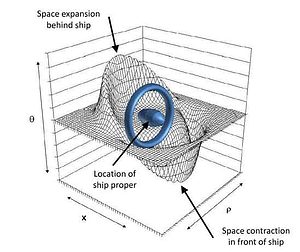We’ve seen a lot of concepts cross the realm of SciFi into reality, however transferring fabrics of imagination to practical applications which respect the laws of physics can be troublesome, if not sometimes impossible. If in a book or TV show, like Star Trek for instance, things like teleportation, time travel or faster than light speeds are explained and applied in terms as simple as flicking a switch, in reality the laws of physics can not be re-written. Inspiration is a wonderful thing, and Star Trek, for one, not only offered some incredible ideas to engineers and inventors across the world, but also nurtured and directed a myrriad of enthuasists towards studying science.
The latest trekkie spin-off is the warp-drive. The concept is simple, in words – nothing can travel faster than the speed of light in space; however, if you’re not in space, you might be able to get around this law – a quantum loophole. Now, bear with me. The whole concept of warp drive revolves around warping space around an object. This warp field, which in theory can be created with a ring of exotic matter wrapped around a football shaped spaceship, will create a region of contracted space in front of it and expanded space behind.
“Everything within space is restricted by the speed of light,” explained Richard Obousy, president of Icarus Interstellar, a non-profit group of scientists and engineers devoted to pursuing interstellar spaceflight. “But the really cool thing is space-time, the fabric of space, is not limited by the speed of light.”
Why building a warp-drive is so hard

Also, there’s another issue which came to scientific attention a few months ago. In a previous post on ZME Science, I wrote how some researchers at Sydney University studied what would happen, were it possible, when a spacecraft would halt its faster than light propulsion and exit warp-drive. “The University of Sydney scientists did a bit of math on the data which would result from the effects of faster than light space travel via Alcubierre drive and found that the warp bubble would gather cosmic particles during its voyage. Since there isn’t such a thing as empty space, the spacecraft in question would most certainly gather particles in its warp bubble, no matter its trajectory. When the spacecraft would eventually come out of warp-drive, and superluminal speeds, the gathered particles would be released in an energetic outburst. These can be as energetic as the powerful gamma-rays, the researchers claim.”
Why are we still talking about this then? It’s clearly unpractical. Well, that’s not what NASA believes. The agency, not a 17-year-old basement discussion group, believes warp drive is plausible and is very much interested in probing its applicability. At the 100 Year Starship Symposium, NASA researcher Harold White held a presentation where he spoke about warp-drives in very real-life terms. Dr. White and other physicists have found loopholes in some mathematical equations, which according to them mean that the required amount of energy is much less than previously thought. More specifically, they found if the ring encircling the spacecraft was adjusted into more of a rounded donut, as opposed to a flat ring, then the required amount of energy would be contained in a few thousand pounds of mass – that’s considerably less than let’s say…Jupiter.
Proof of a working warp-drive
At NASA Eagleworks, Dr. White and colleagues are looking to practically prove the concept of warp-drive by lab experiments. There, the scientists have set-up a mini warp-drive called White-Juday Warp Field Interferometer. “We’re trying to see if we can generate a very tiny instance of this in a tabletop experiment, to try to perturb space-time by one part in 10 million,” White said.
That might not sound like much, but just listen to what Dr. White has to say:
“Although this is just a tiny instance of the phenomena, it will be existence proof for the idea of perturbing space time-a “Chicago pile” moment, as it were. Recall that December of 1942 saw the first demonstration of a controlled nuclear reaction that generated a whopping half watt. This existence proof was followed by the activation of a ~ four megawatt reactor in November of 1943. Existence proof for the practical application of a scientific idea can be a tipping point for technology development.”
Is the warp-drive an outlandish idea? Definitely! But if scientists and mankind wants to reach for stars and travel to distant worlds, well the old fashion rocket boosters aren’t gonna cut it. You need to resort to uncoventional ideas, at least try them out, and Dr. White, a reputable scientist, is on the forefront of viable space travel research.
source
“If we’re ever going to become a true spacefaring civilization, we’re going to have to think outside the box a little bit, we’re going to have to be a little bit audacious,” Obousy said.



